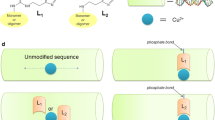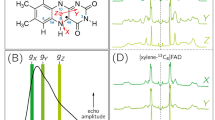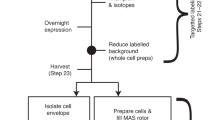Abstract
A protocol is described for the incorporation of nitroxide spin-labels into specific 2′-sites within nucleic acids. This labeling strategy facilitates the investigation of nucleic acid structure and dynamics using electron paramagnetic resonance (EPR) spectroscopy and macromolecular complex formation using paramagnetic relaxation enhancement NMR spectroscopy. A spin-labeling reagent, 4-isocyanato TEMPO, which can be prepared in one facile step or obtained commercially, is used for postsynthetic modification of site-specifically 2′-amino-modified nucleic acids. This spin-labeling protocol has been applied primarily to RNA, but is also applicable to DNA. Subsequently, EPR spectroscopic analysis of the spin-labeled nucleic acids allows for the measurements of distances, solvent accessibilities and conformation dynamics. Using the spin-labeling strategy described here, spin-labeled samples can be prepared in 2–4 d.
This is a preview of subscription content, access via your institution
Access options
Subscribe to this journal
Receive 12 print issues and online access
$259.00 per year
only $21.58 per issue
Buy this article
- Purchase on Springer Link
- Instant access to full article PDF
Prices may be subject to local taxes which are calculated during checkout



Similar content being viewed by others
References
Hubbell, W.L., Cafiso, D.S. & Altenbach, C. Identifying conformational changes with site-directed spin labeling. Nat. Struct. Biol. 7, 735–739 (2000).
Qin, P.Z. & Dieckmann, T. Application of NMR and EPR methods to the study of RNA. Curr. Opin. Struct. Biol. 14, 350–359 (2004).
Fanucci, G.E. & Cafiso, D.S. Recent advances and applications of site-directed spin labeling. Curr. Opin. Struct. Biol. 16, 644–653 (2006).
Karim, C.B., Zhang, Z. & Thomas, D.D. Synthesis of TOAC spin-labeled proteins and reconstitution in lipid membranes. Nat. Protoc. 2, 42–49 (2007).
Edwards, T.E., Okonogi, T.M., Robinson, B.H. & Sigurdsson, S.T. Site-specific incorporation of nitroxide spin-labels into internal sites of the TAR RNA; structure-dependent dynamics of RNA by EPR spectroscopy. J. Am. Chem. Soc. 123, 1527–1528 (2001).
Edwards, T.E., Okonogi, T.M. & Sigurdsson, S.T. Investigation of RNA-protein and RNA-metal ion interactions by electron paramagnetic resonance spectroscopy. The HIV TAR-Tat motif. Chem. Biol. 9, 699–706 (2002).
Edwards, T.E. & Sigurdsson, S.T. EPR spectroscopic analysis of TAR RNA-metal ion interactions. Biochem. Biophys. Res. Commun. 303, 721–725 (2003).
Edwards, T.E. & Sigurdsson, S.T. Electron paramagnetic resonance dynamic signatures of TAR RNA-small molecule complexes provide insight into RNA structure and recognition. Biochemistry 41, 14843–14847 (2002).
Edwards, T.E., Robinson, B.H. & Sigurdsson, S.T. Identification of amino acids that promote specific and rigid TAR RNA-tat protein complex formation. Chem. Biol. 12, 329–337 (2005).
Kim, N.K., Murali, A. & DeRose, V.J. Separate metal requirements for loop interactions and catalysis in the extended hammerhead ribozyme. J. Am. Chem. Soc. 127, 14134–14135 (2005).
Edwards, T.E. & Sigurdsson, S.T. EPR spectroscopic analysis of U7 hammerhead ribozyme dynamics during metal ion induced folding. Biochemistry 44, 12870–12878 (2005).
Schiemann, O., Weber, A., Edwards, T.E., Prisner, T.F. & Sigurdsson, S.T. Nanometer distance measurements on RNA using PELDOR. J. Am. Chem. Soc. 125, 3434–3435 (2003).
Leulliot, N. et al. A new alpha-helical extension promotes RNA binding by the dsRBD of Rnt1p RNAse III. EMBO J. 23, 2468–2477 (2004).
Pham, J.W., Radhakrishnan, I. & Sontheimer, E.J. Thermodynamic and structural characterization of 2′-nitrogen-modified RNA duplexes. Nucleic Acids Res. 32, 3446–3455 (2004).
Barhate, N., Cekan, P., Massey, A.P. & Sigurdsson, S.T. A nucleoside that contains a rigid nitroxide spin label: a fluorophore in disguise. Angew. Chem. Int. Ed. Engl. 46, 2655–2658 (2007).
Macosko, J.C., Pio, M.S., Tinoco, I. Jr. & Shin, Y.K. A novel 5 displacement spin-labeling technique for electron paramagnetic resonance spectroscopy of RNA. RNA 5, 1158–1166 (1999).
Grant, G.P. & Qin, P.Z. A facile method for attaching nitroxide spin labels at the 5′ terminus of nucleic acids. Nucleic Acids Res. 35, e77 (2007).
Caron, M. & Dugas, H. Specific spin-labeling of transfer ribonucleic acid molecules. Nucleic Acids Res. 3, 19–34 (1976).
Qin, P.Z., Butcher, S.E., Feigon, J. & Hubbell, W.L. Quantitative analysis of the isolated GAAA tetraloop/receptor interaction in solution: a site-directed spin labeling study. Biochemistry 40, 6929–6936 (2001).
Kim, N.K., Murali, A. & DeRose, V.J. A distance ruler for RNA using EPR and site-directed spin labeling. Chem. Biol. 11, 939–948 (2004).
Hara, H., Horiuchi, T., Saneyoshi, M. & Nishimura, S. 4-Thiouridine-specific spin-labeling of E. coli transfer RNA. Biochem. Biophys. Res. Commun. 38, 305–311 (1970).
Ramos, A. & Varani, G. A new method to detect long-range protein-RNA contacts: NMR detection of electron-proton relaxation induced by nitroxide spin-labeled RNA. J. Am. Chem. Soc. 120, 10992–10993 (1998).
Qin, P.Z., Hideg, K., Feigon, J. & Hubbell, W.L. Monitoring RNA base structure and dynamics using site-directed spin labeling. Biochemistry 42, 6772–6783 (2003).
Qin, P.Z., Feigon, J. & Hubbell, W.L. Site-directed spin labeling studies reveal solution conformational changes in a GAAA tetraloop receptor upon Mg2+-dependent docking of a GAAA tetraloop. J. Mol. Biol. 351, 1–8 (2005).
Schiemann, O. et al. Spin labeling of oligonucleotides with the nitroxide TPA and use of PELDOR, a pulse EPR method, to measure intramolecular distances. Nat. Protoc. 2, 904–923 (2007).
Piton, N. et al. Base-specific spin-labeling of RNA for structure determination. Nucleic Acids Res. 35, 3128–3143 (2007).
Naber, N. et al. Closing of the nucleotide pocket of kinesin-family motors upon binding to microtubules. Science 300, 798–801 (2003).
Höbartner, C. et al. Syntheses of RNAs with up to 100 nucleotides containing site-specific 2′-methylseleno labels for use in X-ray crystallography. J. Am. Chem. Soc. 127, 12035–12045 (2005).
Martick, M. & Scott, W.G. Tertiary contacts distant from the active site prime a ribozyme for catalysis. Cell 126, 309–320 (2006).
Acknowledgements
The authors thank Kristmann Gislason and Pavol Cekan for their help with manuscript preparation. T.E.E. is a Damon Runyon Cancer Research Foundation Postdoctoral Fellow in the laboratory of Adrian R. Ferré-D'Amaré at the Fred Hutchinson Cancer Research Center in Seattle, Washington, USA (DRG-1844-04).
Author information
Authors and Affiliations
Corresponding author
Ethics declarations
Competing interests
The authors declare no competing financial interests.
Rights and permissions
About this article
Cite this article
Edwards, T., Sigurdsson, S. Site-specific incorporation of nitroxide spin-labels into 2′-positions of nucleic acids. Nat Protoc 2, 1954–1962 (2007). https://doi.org/10.1038/nprot.2007.273
Published:
Issue Date:
DOI: https://doi.org/10.1038/nprot.2007.273
This article is cited by
-
Refining RNA solution structures with the integrative use of label-free paramagnetic relaxation enhancement NMR
Biophysics Reports (2019)
-
Paramagnetic-iterative relaxation matrix approach: extracting PRE-restraints from NOESY spectra for 3D structure elucidation of biomolecules
Journal of Biomolecular NMR (2019)
-
Impact of spin label rigidity on extent and accuracy of distance information from PRE data
Journal of Biomolecular NMR (2017)
-
Site-directed spin-labeling of nucleotides and the use of in-cell EPR to determine long-range distances in a biologically relevant environment
Nature Protocols (2013)
-
Paramagnetic labelling of proteins and oligonucleotides for NMR
Journal of Biomolecular NMR (2010)
Comments
By submitting a comment you agree to abide by our Terms and Community Guidelines. If you find something abusive or that does not comply with our terms or guidelines please flag it as inappropriate.



